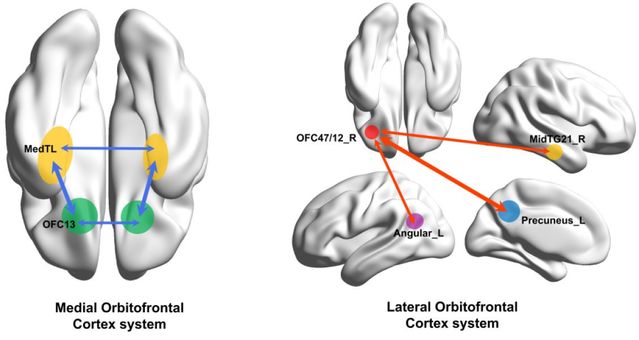Groundbreaking Study Roots Out Signs of Depression in Brain
Groundbreaking Study Roots Out Signs of Depression in Brain
Differences in functional connectivity between parts of the brain emerge
.

The medial orbitofrontal cortex (reward-related
OFC) and lateral orbitofrontal cortex (non-reward-related OFC) networks
have different functional connectivity in patients with depression.
Source: Courtesy of University of Warwick, used with permission
For this study, 909 people (421 patients with major depressive disorder and 488 control subjects) had their brains scanned using advanced MRI neuroimaging technology. Then, the international team of researchers analyzed each person’s functional connectivity between different brain regions. The scientists were able to pinpoint specific neural networks and patterns of functional connectivity between brain regions associated with depression.
Specifically, the researchers found that depression is linked to altered connectivity within various regions of the orbitofrontal cortex (OFC). Interestingly, the medial OFC ‘reward’ systems and lateral OFC ‘non-reward’ systems change connectivity in opposite directions. These findings help to explain the neurobiological underpinnings of how depression is linked with the dejected feeling of not receiving a reward, unhappy memories, and low self-esteem.

Orbitofrontal cortex (OFC) in green.
Source: Wikimedia Commons/Public Domain
Additionally, the researchers found that major depressive episodes are associated with reduced connectivity between the reward centers in the medial OFC and other memory systems in the brain. This could explain why people suffering from clinical depression have difficulty recalling or reliving happy memories.
The good news is that these groundbreaking discoveries could lead to revolutionary breakthroughs in the clinical treatment of depression, including new psychopharmacological treatments and targeted cognitive behavior therapy (CBT) interventions to help those with depression curtail rumination and negative thinking.
Depression is a public health crisis that has reached epidemic proportions around the world. In a statement to University of Warwick, study co-author Jianfeng Feng said,
"More than one in ten people in their lifetime suffer from depression, a disease which is so common in modern society and we can even find the remains of Prozac (a depression drug) in the tap water in London.
Our finding, with the combination of big data we collected around the world and our novel methods, enables us to locate the roots of depression which should open up new avenues for better therapeutic treatments in the near future for this horrible disease."
Depression May Be Rooted in the Functional Connectivity of the Lateral OFC
The latest research by Feng et al. supports the hypothesis that depression is related to increased functional connectivity of the lateral orbitofrontal cortex. These findings also help to explain how a sense of loss and disappointment associated with not receiving rewards are neurobiologically associated with depression.Increasingly, it seems that neuroscientists are pinpointing 'microzones' within specific brain regions that appear to have polar opposite functions. For example, yesterday, a new study on mice from the RIKEN-MIT Center for Neural Circuit Genetics reported that neurons associated with positive memories and reward-seeking behaviors are housed in the back of the amygdala. On the flip side, negative memories and fear-conditioned responses are housed in neurons located in the front of the amygdala.
Along these lines, the new study published today shows that the lateral OFC and medial OFC house non-reward centers linked to depression and more positive reward centers, respectively.
Future research will advance our understanding of how neural networks in specific regions of the orbitofrontal cortex grow stronger through neuroplasticity or weaker through neural pruning. The latest insights into the physical correlates of depression have many implications for creating more effective treatments for depressive disorders. Stay tuned!

